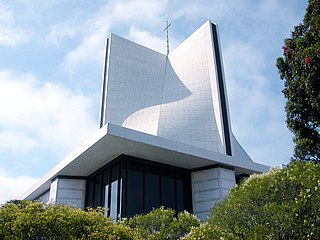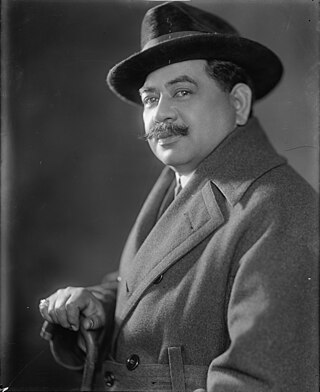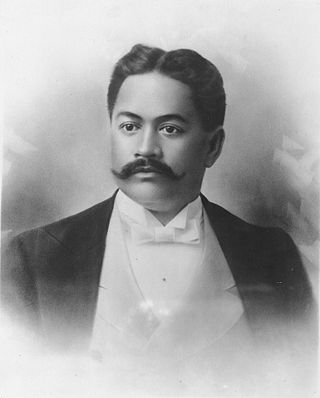
The Archdiocese of San Francisco is a Latin Church ecclesiastical territory or diocese of the Catholic Church in the northern California region of the United States. The Archdiocese of San Francisco was erected on July 29, 1853, by Pope Pius IX and its cathedral is the Cathedral of Saint Mary of the Assumption.

ʻIolani School is a private coeducational college preparatory school in Honolulu, Hawaiʻi. It serves over 2,200 students with a boarding program for grades 9 - 12 as well as a summer boarding program for middle school grades. Founded in 1863 by Father William R. Scott, it was the principal school of the former Anglican Church of Hawaiʻi. It was patronized by Kamehameha IV and Queen Emma who gave the school its name in 1870. ʻIolani in the Hawaiian language means "heavenly hawk". Today, ʻIolani School is affiliated with the Episcopal Church in the United States. It is administered by a Board of Governors and is one of the largest independent schools in the United States.

Kaʻiulani was a Hawaiian royal, the only child of Princess Miriam Likelike, and the last heir apparent to the throne of the Hawaiian Kingdom. She was the niece of King Kalākaua and Queen Liliʻuokalani. After the death of her mother, Princess Kaʻiulani was sent to Europe at age 13 to complete her education under the guardianship of British businessman and Hawaiian sugar investor Theo H. Davies. She had not yet reached her eighteenth birthday when the 1893 overthrow of the Hawaiian Kingdom altered her life. The Committee of Safety rejected proposals from both her father Archibald Scott Cleghorn, and provisional president Sanford B. Dole, to seat Kaʻiulani on the throne, conditional upon the abdication of Liliʻuokalani. The Queen thought the Kingdom's best chance at justice was to relinquish her power temporarily to the United States.

Jonah Kūhiō Kalanianaʻole was a prince of the Kingdom of Hawaiʻi until it was overthrown by a coalition of American and European businessmen in 1893. He later went on to become a representative in the Territory of Hawaii as delegate to the United States Congress, and as such is the only royal-born member of Congress.

David Laʻamea Kahalepouli Kinoiki Kawānanakoa was a prince of the Hawaiian Kingdom and founder of the House of Kawānanakoa. Born into Hawaiian nobility, Kawānanakoa grew up the royal court of his uncle King Kalākaua and aunt Queen Kapiʻolani who adopted him and his brothers after the death of their parents. On multiple occasions, he and his brothers were considered as candidates for the line of succession to the Hawaiian throne after their cousin Princess Kaʻiulani but were never constitutionally proclaimed. He was sent to be educated abroad in the United States and the United Kingdom where he pioneered the sport of surfing. After his education abroad, he served as a political advisor to Kalākaua's successor, Queen Liliʻuokalani until the overthrow of the Hawaiian Kingdom in 1893. After Hawaii's annexation to the United States, he co-founded the Democratic Party of Hawaii.

Quentin Kūhiō Kawānanakoa is an American politician and member of the House of Kawānanakoa. Kawānanakoa is an organizer of the Republican Party of Hawaii. He is also an heir to the James Campbell estate.

The Diocese of Oakland is a Latin Church ecclesiastical territory, or diocese, of the Catholic Church in the San Francisco Bay Area of California in the United States. It is a suffragan diocese in the ecclesiastical province of the metropolitan Archbishop of San Francisco.
Day-care sex-abuse hysteria was a moral panic that occurred primarily during the 1980s and early 1990s, and featured charges against day-care providers accused of committing several forms of child abuse, including Satanic ritual abuse. The collective cases are often considered a part of the Satanic panic. A 1982 case in Kern County, California, United States, first publicized the issue of day-care sexual abuse, and the issue figured prominently in news coverage for almost a decade. The Kern County case was followed by cases elsewhere in the United States, as well as Canada, New Zealand, Brazil, and various European countries.

The Diocese of San Bernardino is a Latin Church ecclesiastical territory, or diocese, in Southern California in the United States. Erected by Pope Paul VI on July 14, 1978, its jurisdiction extends over San Bernardino and Riverside counties. As of 2021, the diocese had 92 parishes and 12 missions in its territory. Its cathedral is Our Lady of the Rosary Cathedral in San Bernardino.
This page documents Catholic Church sexual abuse cases by country.

Edward Abnel Keliʻiahonui was a prince of the Kingdom of Hawaiʻi. His name means "the chief whose strength is attained through patience".
The sexual abuse scandal in the Catholic Archdiocese of Philadelphia, in Pennsylvania, U.S., is a significant episode in the series of Catholic sex abuse cases in the United States, Ireland and elsewhere. The Philadelphia abuses were substantially revealed through a grand jury investigation in 2005. In early 2011, a new grand jury reported extensive new charges of abusive priests active in the archdiocese. In 2012, a guilty plea by priest Edward Avery and the related trial and conviction of William Lynn and mistrial on charges against James J. Brennan followed from the grand jury's investigations. In 2013, Charles Engelhardt and teacher Bernard Shero were tried, convicted and sentenced to prison. Lynn was the first official to be convicted in the United States of covering up abuses by other priests in his charge and other senior church officials have been extensively criticized for their management of the issue in the archdiocese.
The Catholic sexual abuse scandal in Europe has affected several dioceses in European nations. Italy is an exceptional case as the 1929 Lateran Treaty gave the Vatican legal autonomy from Italy, giving the clergy recourse to Vatican rather than Italian law.
The Catholic sexual abuse scandal in Latin America is a significant part of the series of Catholic sex abuse cases.

William Ansel Kinney (1860–1930) was a lawyer and politician in the Kingdom of Hawaii, through the Republic of Hawaii and into the Territory of Hawaii.

Surfing in the United States is a popular hobby in coastal areas, and more recently due to the invention of wave pools, inland regions of the country. It contributes to a lifestyle and culture in which millions participate and which millions more have an interest. USA surfing is the governing body for the sport of surfing in the United States, with surf leagues such as the World Surf League available in the country. Surfing can be traced back to 17th Century Hawaii and has evolved over time into the professional sport it is today, with surfing being included for the first time in the 2020 Summer Olympics in Tokyo.

John Henry Wise was a Native Hawaiian politician, businessman, religious leader, and educator of Hawaii. In his youth, he became the first Native Hawaiian to play college football with the Oberlin Yeomen football team while he attended theology school at Oberlin College. During his political career in the Hawaii Territorial Legislature, he helped pass the Hawaiian Homelands Act of 1921. In later life, he served as an instructor of Hawaiian language at the Kamehameha Schools and the University of Hawaii.

Education of Hawaiian Youths Abroad was a government-funded educational program that commenced April 1, 1880, during the reign of King Kalākaua, to help students further their educations beyond the institutions available in Hawaii at that time. Students were personally selected by Kalākaua, based upon family background and academic excellence. All living accommodations and expenses were taken care of for chosen students enrolled in a foreign university or apprenticed outside of the kingdom of Hawaii to learn a trade.

Liliʻuokalani, the last monarch of Hawaii, died November 11, 1917. The royal standard (flag) was raised over her home at Washington Place to signal to the public that she was deceased. Under military guard, her body was moved at midnight for embalming. After the traditional Hawaiian mourning of chanting and wailing, the public was allowed to view her body covered only by a shroud. Her state funeral was held in the throne room of Iolani Palace, on November 18, 1917, followed by her funeral procession to the Royal Mausoleum of Mauna ʻAla. An estimated 1,500 adults and children were in the funeral procession.

Professor John Wrightson FCS, MRAC was a British agriculturalist and the founder of Downton Agricultural College (1880–1906) at Downton in Wiltshire. In 1890 he reputedly became the first person in Britain to surf, under the guidance of two Hawaiian princes, David Kawānanakoa and Jonah Kūhiō Kalanianaʻole, who were studying at his college.
















